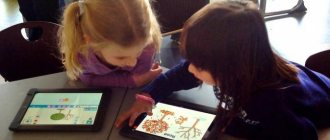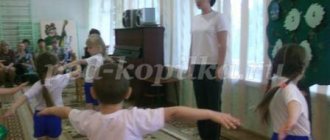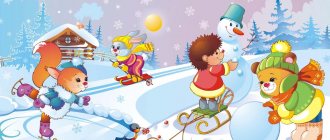Preparatory group. Senior preschool age. Children 6-7 years old
Summary of the lesson on FCCM in the preparatory school group "New Year's toys"
summary for the senior group “New Year’s toys”
Goal: expanding children's understanding of the traditions of celebrating the New Year in Russia.
Objectives: - introduce children to the history of New Year's toys;
- show the variety of materials when making New Year's toys; -... Notes on educational activities in the preparatory correctional group for the FCCM “Zoo” Notes on the educational field “ Cognitive Development ”
section:
“
Acquaintance with the environment ” on the topic:
“Zoo”
in the preparatory correctional group V-l: Mitroshina L.A.
2019 Integration of educational areas: “
Cognitive development ” ,
“Speech development”
,…
The main reason why children do not want to go to school is a lack of interest in learning. How to change the teaching system so that a modern lesson becomes interesting, becomes a lesson in the development of a creative personality. It is necessary to interest the student not in ready-made knowledge, but in riddles and tasks. There are so many of them in the nature around us that we spend our whole lives unraveling them. Everyone will agree that the content of lessons on learning about the world most contributes to maintaining and developing interest in educational and cognitive activities. At the same time, teachers know that cognitive interest does not arise out of nowhere. It needs to be supported and developed. Everyone knows children's curiosity: interest in nature, people, social phenomena. This interest is related to the needs of children of primary school age. If a teacher works in the zone of proximal development, then interest in knowledge deepens. This is a necessary condition for the development of cognitive activity of schoolchildren. Lessons about understanding the world play a huge role in the formation of cognitive interest. Nature surrounds a child from the first moment of birth. With its colors, riddles, secrets, it attracts the child, the baby receives a lot of impressions, which evokes joyful emotions in him, and with great interest the child begins to participate in a wide variety of research activities. World knowledge lessons in primary school account for 2 hours a week. However, students must learn the basics of an important propaedeutic subject that shapes worldview and environmental culture. In this case, it is necessary to intensify the learning process, give it a creative, research character. I propose the following ways to intensify educational activities: - didactic game - research work - logical tasks - problem tasks - creative work of students; - collective cognitive activity. In conducting non-traditional lessons in a varied and exciting form using partially search and research teaching methods, the following help: organizing subject-related activities through an introduction to the lesson of drawing and modeling, creative tasks, conducting lessons using ICT, using didactic material, cards with individual tasks, diagrams - supports, cards with story tasks, creative tasks, tests. Didactic play is of great importance for clarifying and systematizing children’s knowledge, for developing the main components of educational activity - the ability to act in accordance with the rules, to subordinate one’s actions to the actions of other participants in the game, etc. The younger the elementary school student, the more space games should occupy in lessons about learning about the world, especially in the first and second grades. During the game, children get the opportunity to make an incorrect judgment and not receive a negative assessment; they are not afraid to do something differently than usual. For many, play is a means of psychological rehabilitation. Many younger students react painfully to every teacher’s remark and are very worried. In the game, the lack of knowledge or its inaccuracy dissolves in the plot and becomes imaginary. Therefore, the child is not afraid to say something wrong (after all, it is his hero who says it). When selecting a game, it is necessary to pay attention to the presence and clarity of its structural components: didactic goal (task), game rule, game action. A didactic goal is a requirement that the teacher wants to check the mastery of.
For example: Game “What has changed?” when studying the topic “Seasons”: test the ability to notice changes taking place, exercise observation, and spatial orientation. Game "Who is it?" When studying the topic “Animals,” develop children’s ability to write a description of an animal, highlight the features of its appearance and character. Game "Tree, bush, grass?" When studying the topic: “Plants” Develops horizons, observation, and the ability to recognize a plant by its characteristic features.
Research activities are structured in accordance with the following methodological techniques: 1. Identification of the problem. 2. Making assumptions. 3. Discussion of hypotheses. 4. Comparison of the findings with the text of the textbook or the teacher’s story. 5. Search for emotional support (looking at illustrations). 6. Joint preparation of a graphic support plan. With this structure, the student is not afraid to express an erroneous opinion, to make a mistake in reasoning, since he has the opportunity to correct it under the influence of arguments expressed by his peers. Schoolchildren develop critical thinking, self-control and self-esteem, which reflects a fairly high level of their general abilities. The impetus for research activity, for productive thinking aimed at finding a way out of a state of difficulty, is a problematic situation. The means of creating any problematic situation in the educational process are educational problems (task, task, question). The essence of the method of creating problem situations is that knowledge is not offered in ready-made form. Children acquire this knowledge in the process of discussing the contradictions inherent in the situation. Of course, younger schoolchildren consider very simple contradictions and build elementary hypotheses, but for them this path is the most interesting and productive. Here are the simplest and most effective ways to work with the class when using creative tasks in lessons: 1. Groups receive the same task. The result of the group’s work can simply be submitted to the teacher for review. Another option: the “speaker” of one of the groups reports the results of the work, and the rest of the students complement or refute it. An interesting effect occurs when the results of groups work contradict each other. In such cases, the guys “get excited” and, at the peak of their interest, I manage to build a problematic conversation to resolve this contradiction. 2. Groups receive different tasks. Then either the “speakers” of the groups report to the class, or, taking turns, each “speaker” goes around each group in a circle and works with it. 3. Groups receive different but complementary tasks. The problem can be solved “in parts”: each group receives its part of the question; the situation will be revealed only after analyzing the responses of all groups; after which all the results are brought together. Psychological effect: the guys are very proud when the result of their work turns out to be useful to the whole class.
Tasks for discussion: Task No. 1 Suggest how we can strengthen the crumbling slope of a ravine or a bank that is constantly being washed away by water? Possible answer 1. It is proposed to use plant roots to strengthen the soil. For example, in the Crimea, the Spanish gorse plant (Solanaceae family) was planted on the slopes, the powerful roots of which penetrate deep into the slope and strengthen it. Possible answer 2. Reeds were planted near the city of Klaipeda, on the Curonian Spit. The protective strips of this plant, according to the authors of the project, will reliably protect the coast from erosion. In addition, reeds look nicer in appearance than reinforced concrete breakwaters.
Problem No. 2 One rich London lady, having learned that plants purify the air, ordered the servants to move the five largest tubs with tropical plants from the winter garden to her bedroom, which was not ventilated. This morning the lady woke up with a headache. After this, she began to argue that plants do not purify the air, but, on the contrary, spoil it. How do you explain to the lady her mistake? Possible answer 1. Plants photosynthesize only in the light; in the dark, the release of oxygen almost stops. But the breathing process does not reduce its intensity. Consequently, the plants could “breathe out” some of the oxygen contained in the air of the room.
Possible answer 2. The leaves, stems and flowers of many tropical plants are replete with various glands that secrete all kinds of aromatics, such as essential oils. Such plants are not indoor plants, since their secretions are unsafe. The lady was lucky that she escaped with only a headache.
Problem No. 3 The phenomenon of photoperiodism is known. During the day, plant flowers periodically open and close. Each plant has its own time for opening and closing the corolla. During the entire flowering period it practically does not change. How can this phenomenon be used for human benefit? Possible answer. This pattern can be used in the so-called flower clock. From them you can approximately determine the time. Flower clocks have been known since antiquity. Such clocks were built, for example, by Carl Linnaeus in the city of Upeala (Sweden, 18th century), as well as in the Pushkin estate in Mikhailovskoye.
Task No. 4 Why (due to what factors) can a flower clock “break” and start showing the time incorrectly? Possible answer. There may be several reasons. First, geographic latitude must be taken into account. For example, the Pushkin flower clock “went” incorrectly, since the opening and closing times of a particular flower in other places, established by Carl Linnaeus in the conditions of the city of Upeal, required adjustment in other places. Secondly, weather conditions have an effect. Even well-composed flower clocks show relatively accurate time only on a clear, sunny day; in rainy or cloudy weather they “lose their rhythm.”
Task No. 5 The forest is characterized by a tiered arrangement of plants. The plants in the upper layer (forest canopy) were cut down. Name the possible consequences. List the factors whose effects will change. Possible answer. The living conditions of other tiers will change: some plants will die, some will adapt to new conditions. First of all, the illumination of the lower tiers will change, as well as the water regime of the soil and partly the mineral composition (due to a change in the number of “consumers”). All this will lead to a change in the plant community in this area. There is a high probability that shade-loving plants exposed to light will die. Light-loving plants, on the contrary, will grow better. A new generation of shade-loving plants will develop under their canopy.
Task No. 6 In spring and autumn, you can often see fires in which last year’s browned leaves of plants and dry grass are burned. It is believed that this will make new grass grow better. Do you agree with this? Why? Possible answer. Damage to the topsoil in the area where this fire is burning. All this leads to the fact that many lawns in cities are black, lifeless areas.
Task No. 7 In frosty weather, there are noticeably fewer birds in the air. It would seem that it should be the other way around: muscle work increases heat production, and birds should strive to fly more. Why do birds sit more often in cold weather, and sit with their feathers ruffled? Possible answer. In cold weather, birds sit with their feathers fluffed up, creating an airy shirt near their body. During flight, the air around the bird's body changes all the time, taking away heat. This loss can be so severe that a flying bird sometimes freezes to death.

Perhaps any task can be expressed as a logical problem. For example, G. Skrebitsky’s fairy tale “Everyone in His Own Way” can be presented as a logical story of a riddle. Children listen to the reading and answer the question: “Who was the hare talking to?” Students should revive their ideas, remember which animals prepare for winter in this way, and which animals do not behave this way. “The little bunny stood up on his hind legs to get a better look at what was going on there in front. Yes it …….?…. busy near the hole. The hare ran up to him and said hello. “Hello, oblique,” answered...? ... - Wow, I’m tired, even my paws hurt! Look how much earth I raked out of the hole. - Why are you raking it out? - asked the bunny. – For winter, I clean the hole so that it is more spacious. I’ll clean it out, then the moss, drag the fallen leaves there and make a bed. Then I won’t be afraid of winter either. Lie down... Not far from the water, someone large and clumsy was fiddling around an aspen tree. - Hello, buddy, what are you doing here? - asked the bunny. “Yes, I’m working,” he answered slowly, gnawing an aspen tree...? …. “I’ll throw it on the ground, then I’ll start biting the branches, dragging them into the river, and insulating my hut for winter.” You see, my house is on the island - it’s built all out of branches, and the cracks are covered with silt, inside I’m warm and cozy...” If the children find it difficult to answer, you can show them drawings of the animals in question - a badger, a beaver. This principle can be used when reading other works by D. Sladkov, S. Skrebitsky, E. Shima, M. Prishvin, etc. In the first grade, in order to test the ability to solve logical problems, you can use the simplest exercises to develop the ability to think and think. It's about riddles. I will give some examples of riddles about nature. A nimble little animal jumps and jumps through the trees (squirrel). In winter he sleeps, in summer he stirs up raspberries and hives (a bear). This berry is like this: at first it is bitter, but after frost it is sweet (rowan). Low and prickly, sweet and fragrant. If you pick the berries, your hand will hurt (gooseberries). It grew in a swamp and was very sour (cranberry). If you hurt your feet, look for medicine near the road (plantain). The catfish always lies at the bottom of the river and moves its whiskers. A night hunter, this bird has a big head, they say it is wise (owl). What kind of tree is there - there is no wind, but the leaf is trembling? (aspen).
One of the types of logical problems are questions-tests for quick wits, ingenuity, and children's erudition. They can be in the form of game exercises, which are combined into collective games such as “What, why, when?”, “Clever and smart girls”, “Field of miracles”, etc. They can, naturally, be carried out from 1st to 4th grade, but the nature assignments must correspond to the knowledge and level of intelligence of children. It is advisable to conduct them as part of a lesson, subordinating the content to the program topic being taught. Let's give examples.
Topic “Man and his health” (3rd grade) 1. During a long walk, you rubbed your leg. How to relieve pain? a) keep your foot in the water; b) anoint the sore spot with iodine; c) apply a clean plantain leaf to the sore spot. (correct answer is c) 2. What herb decoction is drunk for insomnia? a) valerian; b) dandelion; c) wormwood. (correct answer is a)
Topic “Animals - living beings, organisms” (3rd grade) 1. Which bird skillfully imitates the voices of other birds? a) cuckoo; b) wagtail; c) starling. (correct answer is c) 2. Chicks have a bright red or orange mouth. Why? a) to shout louder; b) so that parents can see that they are hungry; c) to scare away enemies. (correct answer is b) 3. Which insect is considered the most voracious predator? a) butterfly; b) dragonfly; c) ant. (correct answer is b) 4. Who helps distribute plant seeds? a) only birds; b) birds and mice; c) birds, animals, insects, people. (correct answer is c)
Topic “Wild plants” (3rd grade) 1. Which plants have parachute seeds? a) dandelion, thistle, poplar; b) coltsfoot, chamomile, thistle; c) wormwood, bluebell, dandelion. (the correct answer is a) 2. What does botany study? a) botany studies plants; b) botany studies inanimate nature; c) botany studies insects. (correct answer is a)
Problem-based assignments are very interesting for students. The problem can be expressed not only in the form of a question, but is “hidden” from students and presented in the very wording of the task.
"Distribute the words into columns"
this is characteristic of animals (animals can do this)
this is characteristic of humans and animals (both humans and animals can do this)
this is characteristic only of man (only man can do this)
You can give a hint in the form of a selection of words: breathe, move, think, create, eat, care for offspring, invent different machines, draw, compose music, pursue prey, hibernate, get food, grow plants, care for animals.

"Give me the answer to the question"
What properties of air did man use for his inventions? (in the picture there is a hot air balloon and a sailing ship)
Every teacher working with primary schoolchildren knows that children of this age are very fond of various creative tasks, by performing which they can imagine, invent, compose, and transform images of the world around them. The use of exercises that develop imagination, initiative, and creative individuality is a prerequisite for conducting lessons on this subject. When receiving creative tasks, the student does not mindlessly accept a ready-made sample or teacher’s instructions, but he himself equally actively participates in every step of learning - he accepts the educational task, analyzes ways to solve it, puts forward hypotheses, and determines the causes of errors. A sense of freedom of choice makes learning conscious, productive and effective. It should be noted that in this case the nature of perception changes, it becomes a good assistant to thinking and imagination. The construction of a process specifically focused on the development of imagination and thinking fundamentally changes the position of the student - the roles of researcher, creator, and organizer of their activities begin to occupy a significant place
Exercise 1. “Tell about a natural community” One student shows the travel route according to the area plan and reports through which natural communities it passes; the second names the animals and birds that he will meet on his way; the third talks about the plants he will see along the way.
Task 2.
Read the story by V. Bianchi “Whose nose is better?” and write an essay on the topic “Is the writer right?”
Task 3.
The teacher invites the children to listen to a piece of music and compare its mood with the one that arose in each student during a walk in the forest (park, pond). This could be the music of P.I. Tchaikovsky or J. Haydn from “The Four Seasons”, the folk melody “A Birch Tree Stood in the Field” or any piece of music that suits the mood, available in the classroom music library.
Task 4. “Letter to a green friend” The student is introduced to the following situation: “Imagine that somewhere in the depths of the forest a small tree grows. Sometimes it rains, sometimes the wind sways. It happens that a flock of birds arrives on a tree - they sing, fuss, fight... and fly away. This tree said in secret that he really wanted to have a friend - a person who was better than a schoolchild than an adult. And that first he wants to receive a letter from him...” The teacher suggests to the children: “Write to the tree. Maybe one of you will be exactly the friend it is waiting for. Think about what he would like to read about in your letter, what questions to answer, what could you offer the tree so that it would happily agree to be friends with you?” The work can be carried out as a short essay, better - with game elements: the letter is put in an envelope, accompanied by drawings, and the address is filled out.
Task 5. Make a collage “Natural Community”
I consider carrying out a series of environmental projects an important condition for the development of children’s creative abilities, deepening and consolidating educational material.
“Environmental Profession” The goal of the project is to give free rein to children’s imaginations and train them in assessing various types of human impact on nature, to arouse interest in controversial issues, and the need for new knowledge. The first stage of the project is to learn about professions that can be considered environmental. These include workers in forestry, nature reserves, zoos, employees of environmental services, green construction (doctor, driver, astronaut, janitor, gardener, laboratory assistant, etc.). Children collect material about people in these professions and hold meetings with them. The second stage of the project is the protection of the profession. Groups of children prove that their proposed profession is considered environmental: to confirm this, they talk about people in this profession, give facts, show drawings, posters, photographs, and act out stories. The guys from other groups, who are listening at this time, should ask questions and give examples that cast doubt on the guys’ statements about the environmental significance of a particular profession.
“Complaint book” of nature The goal of the project is to record in a book complaints received from plants and animals living in the region. The first stage of the project is an excursion to observe the state of the environment (animals, plants), and study additional scientific literature. The second stage of the project is the story - a description of the complaint, which is conducted on behalf of the animal or plant. Discussion of received complaints and response to them. The third stage is the design of materials, the creation of a book, which contains creative performances and drawings of children. This is a long-term project, which is supplemented as the topics progress. A variation of this project could be the long-term game “Forest Detectives”. Emergency incidents to which forest detectives will respond are any changes in nature (trees were cut down, many flowers were picked in a favorite clearing, a spring was clogged).
Bird “canteen” The goal of the project is to create and organize the regular operation of a bird “canteen” on the territory of the school and at home. The first stage of the project is to study literature on making bird feeders, exchange experiences, and accumulate food. The second stage of the project is an exhibition of manufactured feeders. The third stage of the project is the grand opening of the “dining room”. Organization of duty, bird watching.

During class hours, children report on how their home “canteens” for birds work.
The project method helps to activate the knowledge, skills and abilities of students, stimulates the child’s need for self-realization in creative, personally and socially significant activities; implements the principle of cooperation between children and adults; allows you to combine the collective and individual in the pedagogical process; is a technology that ensures the growth of a child’s personality. My students enjoy performing various creative tasks, because this type of work allows the student to imagine and transform images of the world around them. Games and logical tasks, problematic questions and research work should be mandatory structural elements of a lesson in learning about the world in elementary school. This will enable the teacher to organize the cognitive activity of primary school students.



